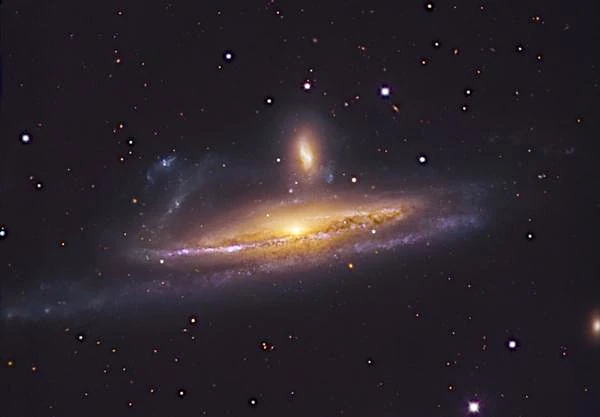
Galactic cannibalism is an astrophysical process by which a large galaxy attracts and absorbs smaller galaxies under the effect of gravity. This phenomenon contributes to the growth of giant galaxies and the formation of extended stellar halos.
Gravitational tidal forces deform and stretch the smaller galaxy, leading to the gradual loss of its stars and gas. Kinetic energy is dissipated, and the materials are progressively integrated into the dominant galaxy, creating stellar streams and matter currents.
This mechanism of cosmic hierarchy, predicted by the ΛCDM model, explains how the massive galaxies we observe today were formed and evolved through successive mergers with satellite galaxies. Our own Milky Way perfectly illustrates this process, having absorbed several dwarf galaxies throughout its history.
The accretion of satellite galaxies occurs through several mechanisms. First, tidal stripping tears stars and dark matter from the satellite galaxy, forming stellar streams and halos. Then, dynamical friction slows down the satellite galaxy, causing it to spiral toward the center of the primary galaxy. Finally, complete assimilation occurs when the satellite is disrupted and its constituents are incorporated into the host galaxy.
N.B.:
Tidal stripping is an astrophysical process where stars and gas from a satellite galaxy are torn away by the gravitational tidal forces exerted by a more massive host galaxy. These forces can stretch the satellite galaxy and form stellar streams or matter currents observable around the dominant galaxy. This mechanism contributes to the formation of extended stellar halos and the morphological evolution of galaxies.
This process alters the morphology, density profile, and chemical composition of the host galaxy. Observations of massive elliptical galaxies often show signatures of past mergers, such as rings, arcs, and diffuse matter flows.
| Galactic system | Type of interaction | Timescale | Observational evidence | Relative mass |
|---|---|---|---|---|
| Milky Way - Sagittarius Dwarf Galaxy | Ongoing accretion | 2-4 billion years | Tidal streams, stellar overdensity | 1:100 |
| Milky Way - Canis Major Dwarf Galaxy | Recent accretion | 1-2 billion years | Overdensity of M-giant stars | 1:300 |
| Milky Way - Enceladus Galaxy (Gaia-Enceladus) | Major past merger | 8-10 billion years | Distinct stellar population in the halo | 1:4 |
| Andromeda Galaxy (M31) - M32 | Advanced absorption | Past merger | Dynamical disturbances, thick disk | 1:50 |
| Andromeda Galaxy - Triangulum Galaxy (M33) | Future interaction | Collision expected in 2-4 billion years | Deformation of M33's outer arm | 1:10 |
| Sombrero Galaxy (M104) | Major merger | 1-2 billion years | Extended halos, stellar shells | 1:3 (merger) |
| Virgo Cluster - Elliptical galaxies | Cluster cannibalism | Ongoing | Multiple nucleus galaxies, tidal streams | Variable |
| NGC 4676 (The Mice) | Ongoing collision | 150-200 million years | Extended tidal tails | 1:1 |
| Antennas (NGC 4038/4039) | Advanced merger | 100-200 million years | Double tail, starburst | 1:1.3 |
| NGC 520 | Intermediate merger | 300 million years | Disturbed disk, matter bridge | 1:1.5 |
| NGC 3256 | Starburst galaxy merger | 400 million years | Tidal tail, double nuclei | 1:1 |
| NGC 1275 (Perseus Galaxy) | Active cannibalism with multiple galaxies | Ongoing | Filament systems, multiple nuclei | 1:10 to 1:100 |
| Cigar Galaxy (M82) | Interaction with M81 | 100 million years | Starburst, HI emission | 1:2 |
| NGC 7727 | Advanced merger | 1 billion years | Multiple shells, stellar streams | 1:2 |
| ESO 593-8 (Tinker Bell Triplet / IRAS 19115-2124) | Ongoing triple merger | Ongoing (active phase) | Three galactic nuclei, multiple tidal tails | 1:1.2:2.5 |